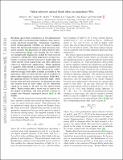Valley-selective optical Stark effect in monolayer WS[subscript 2]
Author(s)
McIver, James; Lee, Yi-Hsien; Fu, Liang; Kong, Jing; Gedik, Nuh; Sie, Edbert Jarvis; ... Show more Show less
DownloadFu_Valley-selective.pdf (4.259Mb)
PUBLISHER_POLICY
Publisher Policy
Article is made available in accordance with the publisher's policy and may be subject to US copyright law. Please refer to the publisher's site for terms of use.
Terms of use
Metadata
Show full item recordAbstract
Breaking space–time symmetries in two-dimensional crystals can markedly influence their macroscopic electronic properties. Monolayer transition metal dichalcogenides (TMDs) are prime examples where the intrinsically broken crystal inversion symmetry permits the generation of valley-selective electron populations, even though the two valleys are energetically degenerate, locked by time-reversal symmetry. Lifting the valley degeneracy in these materials is of great interest because it would allow for valley-specific band engineering and offer additional control in valleytronic applications. Although applying a magnetic field should, in principle, accomplish this task, experiments so far have not shown valley-selective energy level shifts in fields accessible in the laboratory. Here, we show the first direct evidence of lifted valley degeneracy in the monolayer TMD WS[subscript 2]. By applying intense circularly polarized light, which breaks time-reversal symmetry, we demonstrate that the exciton level in each valley can be selectively tuned by as much as 18 meV through the optical Stark effect. These results offer a new way to control the valley degree of freedom, and may provide a means to realize new Floquet topological phases in two-dimensional TMDs.
Date issued
2014-12Department
Massachusetts Institute of Technology. Department of Electrical Engineering and Computer Science; Massachusetts Institute of Technology. Department of PhysicsJournal
Nature Materials
Publisher
Nature Publishing Group
Citation
Sie, Edbert J., James W. McIver, Yi-Hsien Lee, Liang Fu, Jing Kong, and Nuh Gedik. “Valley-Selective Optical Stark Effect in Monolayer WS[subscript 2].” Nat Mater 14, no. 3 (December 15, 2014): 290–294.
Version: Author's final manuscript
ISSN
1476-1122
1476-4660